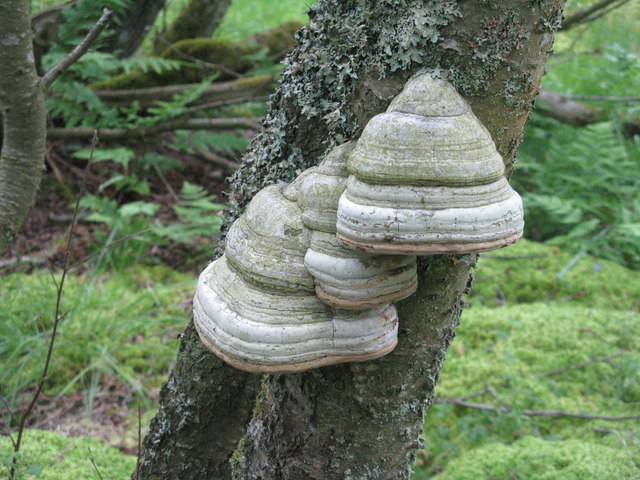Introduction
Fomes fomentarius, also referred to as hoof fungus, tinder fungus, horsehoof tinder fungus, horse fungus, false tinder fungus, tinder conk, tinder polypore, and ice man fungus, is a fungal pathogen that infects various tree species. Hoof fungus produces distinct fruiting bodies that are generally shaped like a horse’s hoof. The pathogen infects susceptible trees through branch or bark wounds. Once established, the fungus causes a stem rot, which typically culminates in the death of the host. After the host has expired, the pathogen becomes a saprotroph, decaying the rest of the organic matter.
Hoof fungus was first described by the Swedish botanist Carl Linnaeus in his landmark book Species Plantarum. Linnaeus dubbed the pathogen Boletus fomentarius. Years later, the famed botanist Magnus Fries moved the species to the genus Fomes. Fomentarius is derived from the latin word Fomentum, meaning kindling or tinder.
Distribution & Habitat
Hoof fungus is prevalent across Europe, Asia, Africa, and North America. It can be found wherever susceptible trees are present.
Hosts
Hoof fungus infects numerous trees. In the northern part of its range, its primary host is birch. In the southern part of its range, hoof fungus favors beech trees, particularly those that are suffering from beech bark disease. Oak, maple, cherry, hickory, lime tree, poplar, willow, alder, hornbeam, sycamore, and select conifers are also infected, albeit with less frequency.
Disease Cycle
The fungal spores penetrate trees through damaged bark, branch stubs, and other wounds. The fungus causes a white rot in the wood of living and dead trees. Depending on where the infection first occurs, the fungus develops within the wood, or on the bark. Fruiting bodies form on the infected area. These fruiting bodies vary in color from silvery grey to light brown. The fruiting bodies attach broadly to the side of host trees. They have prominent, concentric ridges, with rounded margins that make them resemble a horse’s hoof. Occasionally, the fruiting bodies may appear more bracket-like. The margins are white to tan during the growing season. The flesh has a rough exterior that is 1 to 2 mm thick. Circular pores are located on the underside of each fruiting body. The pores are initially white. As the fruiting bodies mature, the pores darken to brown. Tubes protrude outwards from the fruiting bodies. They are 2 to 7 mm long, with a ruddy coloration. Each fruiting body measures 2 to 18 inches in diameter, and 1 to 10 inches wide.
The fruiting bodies produce yellow spores, which are released in abundance when conditions are sufficiently moist. The spores are disseminated by air currents, splashes of rain, or insect vectors to vulnerable trees, which they readily infect. Sporulation is generally most intense in spring. During rainy years, the fruiting bodies may continue to expel spores into fall. At first, the fungus is parasitic. Once the host expires, the fungus becomes a saprotrophic feeder. The fungus can survive as a saprotroph for years, until the host has completely decomposed.
Symptoms of Infection
Infected wood will become discolored, turning light brown to grey. As the decay advances, the wood softens, and brightens to a pale yellow-brown. When conditions are dry, the spores may be observed as a white powder on different surfaces. Small radial cracks, which are filled with yellow mycelium, may form on infected bark, lending the decayed wood a mottled appearance.
Uses
The flesh of the fruiting bodies is the main ingredient of amadou. Amadou is a material that is used primarily as tinder. To create amadou, the fungal bodies are collected from infected trees, and the rough outer layer is scraped off, revealing the spongy inner flesh. The flesh is then soaked in water. Once removed from the water, the flesh is cut into strips, which are subsequently beaten, stretched, and separated into fibers. Amadou was an important resource for many ancient civilizations. This was affirmed in 1991 when the 5,000 year old remains of Ötzi the Iceman were discovered on the Ötzal Alps. Ötzi had several amadou in his possession prior to his death, which it has been concluded he intended to use as tinder.
Amadou has been used as a material to craft items as varied as hats, gloves, pants, picture frames, and ornaments. Surgeons have used amadou as a styptic. Dentists historically applied amadou to dry teeth. Amadou is water absorbent, making it an ideal for use in fly fishing. The amadou is wrapped around wet flies, which enables them to dry out. In Siberia, amadou is mixed with tobacco, and sniffed. Entomologists use amadou to mount insects. In China, amadou is used to treat uterine, stomach, and throat cancer.
Management
- Avoid mechanical injuries to potential hosts.
- Maintain trees through sound cultural practices. Ensures that trees are sufficiently watered. Each year, apply fresh organic mulch around the base of trees to improve the soil quality, moderate the soil temperature, and retain soil moisture.
- Prune broken or damaged branches.
- Culling infected trees may prevent the fungus from spreading, and achieve some control.
Additional Resources
https://books.google.com/books?id=cHnLCQAAQBAJ&pg=PA281#v=onepage&q&f=false
http://www.iceman.it/en/the-iceman/
Photo courtesy of M. J. Richardson CC-by-2.0
